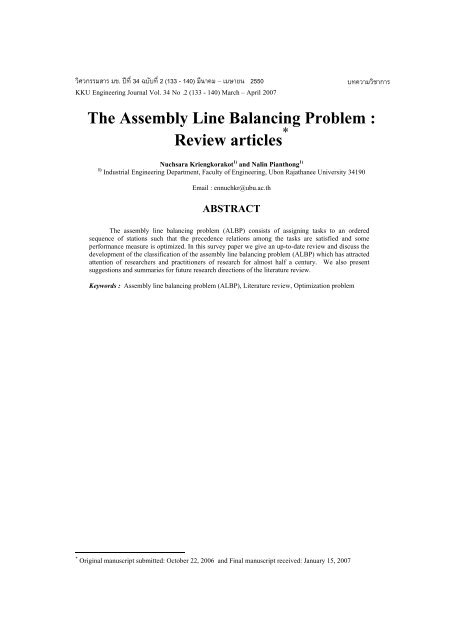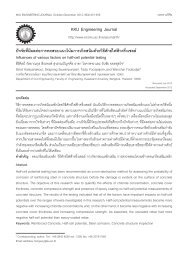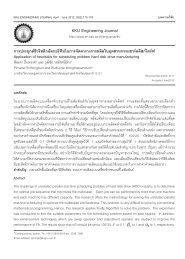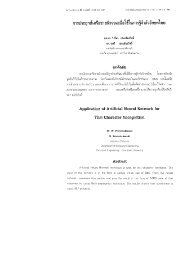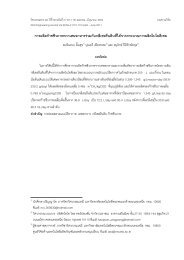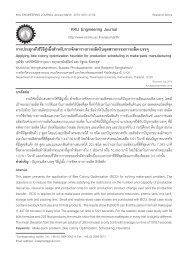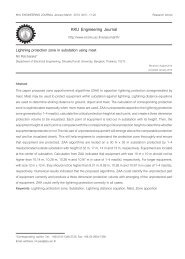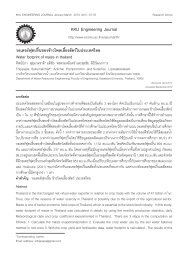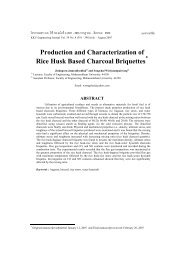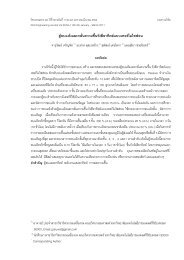The Assembly Line Balancing Problem : Review articles
The Assembly Line Balancing Problem : Review articles
The Assembly Line Balancing Problem : Review articles
Create successful ePaper yourself
Turn your PDF publications into a flip-book with our unique Google optimized e-Paper software.
วิศวกรรมสาร มข. ปที่ 34 ฉบับที่ 2 (133 - 140) มีนาคม – เมษายน 2550KKU Engineering Journal Vol. 34 No .2 (133 - 140) March – April 2007บทความวิชาการ<strong>The</strong> <strong>Assembly</strong> <strong>Line</strong> <strong>Balancing</strong> <strong>Problem</strong> :<strong>Review</strong> <strong>articles</strong> *Nuchsara Kriengkorakot 1) and Nalin Pianthong 1)1) Industrial Engineering Department, Faculty of Engineering, Ubon Rajathanee University 34190Email : ennuchkr@ubu.ac.thABSTRACT<strong>The</strong> assembly line balancing problem (ALBP) consists of assigning tasks to an orderedsequence of stations such that the precedence relations among the tasks are satisfied and someperformance measure is optimized. In this survey paper we give an up-to-date review and discuss thedevelopment of the classification of the assembly line balancing problem (ALBP) which has attractedattention of researchers and practitioners of research for almost half a century. We also presentsuggestions and summaries for future research directions of the literature review.Keywords : <strong>Assembly</strong> line balancing problem (ALBP), Literature review, Optimization problem* Original manuscript submitted: October 22, 2006 and Final manuscript received: January 15, 2007
134 Nuchsara Kriengkorakot and Nalin PianthongIntroduction<strong>The</strong> fundamental of line balancing problems is to assign the tasks to an ordered sequence of stations,such that the precedence relations are satisfied and some measurements of effectiveness are optimized. (e.g.minimize the balance delay or minimize the number of work stations; etc)<strong>The</strong> first published paper of the assembly line balancing problem (ALBP) was made by Salveson(1955) who suggested a linear programming solution. Since then, the topic of line balancing has been of greatinterest to researchers. However, since the ALB problem falls into the NP hard class of combinatorialoptimization problems (Gutjahr and Nemhauser, 1964), it has consistently developed the efficient algorithms forobtaining optimal solutions. Thus numerous research efforts have been directed towards the development ofcomputer-efficient approximation algorithms or heuristics (e.g. Kilbridge and Wester, 1961; Helgeson and Birnie,1961; Hoffman, 1963; Mansoor, 1964; Arcus, 1966; Baybar, 1986a) and exact methods to solve the ALBproblems. (e.g. Jackson, 1956; Bowman, 1960; Van Assche and Herroelen, 1978; Mamoud, 1989; Hackman etal., 1989; Sarin et al., 1999)In addition, with the growth of knowledge on the ALB problem, review <strong>articles</strong> are necessary toorganize and summarize the finding for the researchers and practitioners. In fact, several <strong>articles</strong> (e.g. Kilbridgeand Wester, 1962; Mastor, 1970; Johnson,1981; Talbot et al.,1986; Baybars, 1986b; Ghosh and Gagnon, 1989;Erel and Sarin, 2001) have reviewed the work published on this problem. Recently two <strong>articles</strong> by Scholl andBecker (2006); Becker and Scholl (2006) provide the state-of-the-art exact and heuristic solution procedures forsimple assembly line balancing (SALB) and a survey on problems and methods in generalized assembly linebalancing (GALB) respectively. In this paper, we give an up-to-date review, discuss about the development of theclassification of the ALBP and summary of the future research suggestions from the review <strong>articles</strong>.A Definition of <strong>Assembly</strong> <strong>Line</strong> <strong>Balancing</strong> (ALB)Basic problem of ALBAn assembly line consists of work stations k = 1,…., m usually arranged along a conveyor belt or asimilar material handling equipment. <strong>The</strong> jobs are consecutively launched down the line and are moved fromstation to station. At each station, certain operations are repeatedly performed regarding the cycle time. Ingeneral, the line balancing problem consists of optimally balancing the assembly work among all stations withrespect to some objective. For this purpose, the total amount of work necessary to assemble a work piece (job) issplit up into a set V = {1,…., n} of elementary operations named tasks. Performing a task j takes a task time t jand requires certain equipment of machines and/or skills of workers. <strong>The</strong> total workload necessary for assemblinga work piece is measured by the sum of task times ∑ t . <strong>The</strong>se elements can be summarized by a precedencediagram. It contains a node for each task, node weights for the task times, arcs the direct and paths for the indirectprecedence constraints. Figure 1 shows a precedence diagram with n = 9 tasks having task times between 2-9 intime unit.5 6 41 274 5 4 53 4 562 98 9Figure 1. Precedence diagram
<strong>The</strong> <strong>Assembly</strong> <strong>Line</strong> <strong>Balancing</strong> <strong>Problem</strong> : <strong>Review</strong> <strong>articles</strong> 135A feasible line balance, i.e. an assignment of tasks to stations has to ensure that no precedencerelationship is violated. <strong>The</strong> set S k of tasks assigned to a station k constitutes its station load or work content,the cumulated task time t (S k ) =∑ j∈Skt is called station time. When a fixed cycle time c is given (pacedjline), a line balance is feasible only if the station time of neither station exceeds c. In case of t (S k ) < c , thestation k has an idle time of c – t(S k ) time unit in each cycle. For example in Figure 1, a feasible line balancewith cycle time c =11 and number of station , m = 5 stations is given by stations loads ; S1 ={1,3}, S2 ={2,4},S3 = {5,6}, S4 = {7,8} , S5 = {9} A usual objective consists in maximizing the line utilization which ismeasured by the line efficiency E as the productive fraction of the line’s total operating time and directlydepends on the cycle time c and the number of stations m. In the most simple case, the line efficiency is definedas follows : E = t /( m*c)∑Classification of ALBPIn this section, we provide characteristics of balancing problems considered in the literature and givesome classification schemes (c.f., e.g., Ghosh and Gagnon, 1989; Scholl and Becker, 2006; Becker and Scholl,2006)1 Ghosh and Gagnon (1989) classified the ALBP into four categories; as shown in Figure 2(1) Single Model Deterministic (SMD) (2) Single Model stochastic (SMS)(3) Multi/Mixed Model Deterministic (MMD) (4) Multi/Mixed Model stochastic (MMS)ALB literatureSingle modelMulti-Mixed modelDeterministic(SMD)Stochastic(SMS)Deterministic(MMD)Stochastic(MMS)Simple(SALB)General(GALB)Simple(SALB)General(GALB)Simple(SALB)General(GALB)Simple(SALB)General(GALB)Figure 2. Classification of assembly line balancing literature (Ghosh and Gagnon, 1989)<strong>The</strong> SMD version of the ALB problem assumes dedicated, single model assembly lines where the tasktimes are known deterministically and an efficiency criterion is to be optimized. This is the original and simplestform of the assembly line balancing problem (SALB). Introduce other restrictions or factors(e.g. parallel stations,zoning restrictions) into the model and the problem becomes the General <strong>Assembly</strong> <strong>Line</strong> <strong>Balancing</strong> <strong>Problem</strong>(GALB)<strong>The</strong> SMS problem category introduces the concept of task-time variability. This is more realistic formanual assembly lines, where workers’ operation times are seldom constant. With the introduction of stochastictask times many other issues become relevant, such as station times exceeding the cycle time (and perhaps theproduction of defective or unfinished parts), pacing effects on workers’ operation times, station lengths, the sizeand location of inventory buffers, launch rates and allocation of line imbalances.
136 Nuchsara Kriengkorakot and Nalin Pianthong<strong>The</strong> MMD problem formulation assumes deterministic task times, but introduces the concept of anassembly line producing multiple products. Multi-model lines assemble two or more products separately inbatches. In mixed-model lines single units of different models can be introduced in any order or mix to the line.Multi-mixed model lines introduce various issues that are not present in the single-model case. Model selection,model sequencing and launching rate(s) and model lot sizes become more critical issues here than in the singlemodel case.<strong>The</strong> MMS problem perspective differs from its MMD counterpart in that stochastic times are allowed.However, these issues become more complex for the MMS problem because factors such as learning effects,worker skill level, job design and worker task time variability become more difficult to analyze because the lineis frequently rebalanced for each model assembled.2 Scholl and Becker (2006); Becker and Scholl (2006)<strong>The</strong>y have classified the main characteristics of assembly line balancing problems considered in theirseveral constraints and different objectives as shown in Figure 3. It has illustrated the classification of assemblyline balancing problems.<strong>Assembly</strong> line balancing problemsSimple assembly line balancing problem(SALBP)General assembly line balancing problem(GALBP)SALBP-1 SALBP-2 SALBP-E SALBP-F MALBP/ MSP UALBP OthersFigure 3. classification of assembly line balancing problems(1) SALBP : <strong>The</strong> simple assembly line balancing problem is relevant for straight single productassembly lines where only precedence constraints between tasks are considered (for a survey see Scholl andBecker, 2006)- Type 1 (SALB-1) of this problem consists of assigning tasks to work stations such that the numberof stations (m) is minimized for a given production rate (fixed cycle time, c).- Type 2 (SALBP-2) is to minimize cycle time (maximize the production rate) for a given number ofstations (m).- Type E (SALBP-E) is the most general problem version maximizing the line efficiency (E) therebysimultaneously minimizing c and m considering their interrelationship.- Type F (SALBP-F) is a feasibility problem which is to establish whether or not a feasible linebalance exists for a given combination of m and c.(2) GALBP : In the literature, all problem types which generalize or remove some assumptions ofSALBP are called generalized assembly line balancing problems (GALBP). This class of problems (includingUALBP and MALBP) is very large and contains all problem extensions that might be relevant in practiceincluding equipment selection, processing alternatives, assignment restrictions etc. (for a survey see Becker andScholl, 2006).- MALBP and MSP : Mixed model assembly lines produce several models of a basic product in anintermixed sequence. Besides the mixed model assembly line balancing problem (MALBP), which has to assigntasks to stations considering the different task times for the different models and find a number of stations and a
<strong>The</strong> <strong>Assembly</strong> <strong>Line</strong> <strong>Balancing</strong> <strong>Problem</strong> : <strong>Review</strong> <strong>articles</strong> 137cycle time as well as a line balance such that a capacity- or even cost-oriented objective is optimized (cf. Scholl,1999, Chapter 3.2.2). However, the problem is more difficult than in the single-model case, because the stationtimes of the different models have to be smoothed for each station (horizontal balancing; cf. Merengo et al.,1999). <strong>The</strong> better this horizontal balancing works, the better solutions are possible in the connected short-termmixed model sequencing problem (MSP). MSP has to find a sequence of all model units to be produced such thatinefficiencies (work overload, line stoppage, off-line repair etc.) are minimized.(e.g. Bard et al., 1992 and Scholl et al., 1998)- UALBP : <strong>The</strong> U-line balancing problem (UALBP) considers the case of U-shaped (single product)assembly lines, where stations are arranged within a narrow U. As a consequence, worker are allowed to work oneither side of the U, i.e. on early and late tasks in the production process simultaneously. <strong>The</strong>refore, modifiedprecedence constraints have to be observed. By analogy with SALBP, different problem types can bedistinguished. (cf. Miltenburg and Wijngaard, 1994; Urban , 1998; Scholl and Klein,1999; Erel et al., 2001)Objective criteria and methodological techniquesObjective criteria1 Ghosh and Gagnon (1989)Various technical and economic objective criteria have been used in the ALB literature ,Ghosh andGagnon (1989). As can be seen in Table 1, the seven technical criteria, which relate to throughput operationalefficiency, have in aggregate been the more commonly employed (58:13). Within the technical category,minimizing the number of work stations has been the most chosen.Economic criteria typically relate to assembly line operating cost or profitability measures. Table 1 listssix economic criteria found in the literature, all the economic criteria consider labor cost or labor idleness cost,the most popular criterion and the apparent trend is to include other cost such as product incompletions (Kottasand Lau, 1973), penalty costs (Dar-El, 1977) and inventory and set-up costs (Caruso, 1965). While the technicalcriteria have been the classical dominant choice, economic criteria have gained rapid attention of researcher sincethe mid-1970s.Type of objective criteriaFrequency of useSMD SMS MMD MMS total1. Technical-min. the no. of work st.(given cycle time) 16 2 2 1 21-min. the cycle time (given no. of ws.) 13 1 2 0 16-min. the total Idle time along the line 9 0 3 0 12-min. the balance delay 2 0 1 0 3-min. the overall facility or line length 0 0 2 0 2-min. the throughput time 0 0 1 0 1-min. the probability that one or more0 1 1 1 3work stations will exceed the cycle timetotal 40 4 12 2 582. Economic-min. the combined cost of labour,0 3 0 1 4ws. and product incompleteness-min. the labour cost/unit 3 1 0 0 4-min. the total penalty cost for a no.0 0 2 0 2of inefficiencies-min. the inventory, set up and idle0 0 1 0 1time cost-min. the total in-process inventory costs 0 1 0 0 1-max. the net profit 1 0 0 0 1total 4 5 3 1 13Table 1 : ALB objective criteria (Ghosh and Gagnon, 1989)
138 Nuchsara Kriengkorakot and Nalin Pianthong2 Scholl (1999) (Chapter 1.3.10)From literature, he has mainly classified the objective criteria into two categories; capacity orientedgoals and cost oriented goals.• Capacity oriented goals. Most commonly, ALBP contain the objective of maximizing the capacityutilization of the line which is measured by the line efficiency (E). In case of deterministic operation times andsingle-model production, the line efficiency only depends on the cycle time and the number of stations. <strong>The</strong>simpler objectives are often considered :- minimize the number of stations for a given cycle time.- minimize the cycle time for a given number of stations.- minimizing the balance delay time (sum of idle times) and the balance delay (percentage of idletimes) over all stations, etc.• Cost oriented goals. An important objective is to minimize the total costs of line including long-terminvestment costs and short-term operating costs. <strong>Assembly</strong> line production systems may concern the followingcost categories (i.e. costs of machinery and tools, wage costs, material costs, etc. (for detail see Scholl, 1999,Chapter 1.3.10 pp.21-22 ) which are mainly influenced by the cycle time and the number of stations (cf. Deckro,1989; Rosenberg and Ziegler, 1992; Amen, 2000 a, 2000b, 2001 and Scholl and Becker, 2003). In the literature,usually only one objective is used, while other goals are formulated as constraints. Only few references deal withmultiple objective assembly line balancing problems, namely, Baybars (1985), Shtub and Dar-El (1990), Deckroand Rangachari (1990), Malakooti (1991,1994) and Malakooti and Kumar (1996).Methodological techniques<strong>The</strong> large combinational complexity of the ALB problem has resulted in enormous computationaldifficulties. To achieve optimal or at least acceptable solutions, various solution methodologies have beenexplored. <strong>The</strong>se methods are organized and their use analyzed in Table 2.Frequency of useALB techniquesSMD SMS MMD MMS total1. Exact methods- <strong>Line</strong>ar Programming (LP) 1 0 0 0 1- Integer Programming (IP) 7 0 1 0 8- Dynamic Programming (DP) 4 2 0 0 6- Goal Programming (GP) 1 0 0 0 1- Shortest-path tech. (SP) 2 0 2 0 4- Maximal-path tech. (MP) 1 0 0 0 1- Branch and bound (BB) 11 1 0 1 13total 342. Inexact methods or heuristic- Priority ranking and assignment 10 5 7 *2+sim 24- Tree search (heuristic BB) 8 1 0 0 9- Trade and transfer 1 2 1 0 4- Random sampling 3 1 0 0 4- Others ; task grouping,approximation tech.5 3 1 *2+sim 11total 52Table 2 : ALB methodological techniques (Ghosh and Gagnon, 1989)* Refers to two research studies which combined priority ranking procedures with simulation programs.Despite recent advances in problem formulation and solution procedure efficiency, mathematicalprogramming/network-based optimization techniques are still computationally prohibitive beyond limitedproblem dimensions. It is also unlikely that computational efficiency will progress sufficiently in the near term toallow the use of even the most efficient exact techniques to obtain optimal solutions to realistically sized GALBproblems. <strong>The</strong>refore, heuristic and metaheuristic techniques (e.g. Simulated Annealing (SA), Tabu Search (TS),
<strong>The</strong> <strong>Assembly</strong> <strong>Line</strong> <strong>Balancing</strong> <strong>Problem</strong> : <strong>Review</strong> <strong>articles</strong> 139Genetic Algorithm (GA) and Ant Colony Optimization (ACO), etc.) still remain the only computationallyefficient and sufficiently flexible methodologies capable of addressing large-scale, real-world ALB situations,particularly for the multi/mixed model and GALBP categories.Conclusion and future researchIn the literature survey, it shows that research has made significant algorithm developments in solvingsimple problems (SALBP). Though SALBP is a class of NP-hard optimization problems, effective exact andheuristic algorithms are available which solve small and medium-size instances of problems. Nevertheless,further algorithmic improvement is necessary for solving large-scale problems.Recently, assembly line balancing research evolved towards formulating and solving generalizedproblem (GALBP) with different additional characteristics such as cost functions, paralleling, equipmentselection, u-line layout and mixed-model production. In the literature survey on GALBP (cf. Becker and Scholl,2006) shows that a lot of relevant problems have been identified and modeled but development of sophisticatedsolution procedures has just begun. <strong>The</strong>n, additional research is necessary to adopt state-of-the-art solutionconcepts like metaheuristics and highly developed algorithms for SALBP to the variety of GALBP. Moreover,standardized and realistic test beds are required for testing and comparing methodical enhancements.REFERENCESAmen, M., 2000a. An exact method for cost-oriented assembly line balancing. International Journal ofProduction Economics. Vol.64: pp.187-195.Amen, M., 2000b. Heuristic methods for cost-oriented assembly line balancing: A survey. InternationalJournal of Production Economics. Vol.68: pp.1-14.Amen, M., 2001. Heuristic methods for cost-oriented assembly line balancing: A comparison on solutionquality and computing time. International Journal of Production Economics. Vol.69: pp.255-264.Arcus A.L., 1966. COMSOAL: A Computer Method of Sequencing Operations for <strong>Assembly</strong> <strong>Line</strong>s.International Journal of Production Research. Vol. 4, No.4: pp.259-277.Bard, J.F., Dar-El, E., Shtub, A., 1992. An analytic framework for sequencing mixed model assembly lines.International Journal of Production Research. Vol. 30: pp.35-48.Baybars, I., 1985. On currently practiced formulations of the assembly line balancing problem. Journal ofOperations Management. Vol. 5: pp.449-453.Baybar, I., 1986a. An Efficient Heuristic Method for the Simple <strong>Assembly</strong> <strong>Line</strong> <strong>Balancing</strong> <strong>Problem</strong>.International Journal of Production Research. Vol. 24, No.1: pp.149-166.Baybars, I., 1986b. A Survey of Exact Algorithms for the Simple <strong>Assembly</strong> <strong>Line</strong> <strong>Balancing</strong> <strong>Problem</strong>.Management Science. Vol.32, No. 8: pp.909-932.Becker, C. and A. Scholl., 2006. A Survey on <strong>Problem</strong>s and Methods in Generalized <strong>Assembly</strong> <strong>Line</strong><strong>Balancing</strong>. European Journal of Operational Research. Volume 168, Issue 3: pp. 694-715.Bowman, E.H., 1960. <strong>Assembly</strong> <strong>Line</strong> <strong>Balancing</strong> by <strong>Line</strong>ar Programming. Operations Research.Vol.8,No.3: pp.385-389.Caruso, F.R., 1965. <strong>Assembly</strong> line balancing for improved profits. Automation. Volume 12, January.Dar-El, E.M., and Curry, S., 1977. Optimal mixed-model sequencing for balanced assembly <strong>Line</strong>s. Omega.Vol. 5, pp.333-341.Deckro, R.F., 1989. <strong>Balancing</strong> cycle time and workstations. IIE Transactions. Vol. 21: pp.106-111.Deckro, R.F. and Rangachari, S., 1990. A Goal approach to assembly line balancing. Computers &Operations Research. Vol. 17: pp.509-521.Erel, E. and S.C. Sarin., 1998. A Survey of the <strong>Assembly</strong> <strong>Line</strong> <strong>Balancing</strong> Procedures. Production Planningand Control. Vol.9, No.5: pp.414-434.Erel E., I. Sabuncuoglu and B.A. Aksu, 2001. <strong>Balancing</strong> of U-type <strong>Assembly</strong> Systems Using SimulatedAnnealing. International Journal of Production Research. Vol. 39, No.13: pp.3003-3015.Ghosh S. and R. J. Gagnon., 1989. A Comprehensive Literature <strong>Review</strong> and Analysis of the Design,<strong>Balancing</strong> and Scheduling of <strong>Assembly</strong> Systems. International Journal of Production Research.Vol. 27, No.4: pp.637-670.Gutjahr, A. L., Nemhauser, G.L., 1964. An algorithm for the line balancing problem. Management Science.Vol. 11, No.2: pp. 08-315.
140 Nuchsara Kriengkorakot and Nalin PianthongHackman, S.T., M. J. Magazine and T. S. Wee., 1989. Fast, Effective Algorithms for Simple <strong>Assembly</strong> <strong>Line</strong><strong>Balancing</strong> <strong>Problem</strong>s. Operations Research. Vol.37,No.6: pp.916-924.Helgeson, W.P. and Birnie, D.P., 1961. <strong>Assembly</strong> <strong>Line</strong> <strong>Balancing</strong> Using the Ranked Positional Weight-Technique. <strong>The</strong> Journal of Industrial Engineering. Vol. 12, No. 6: pp.394-398.Hoffmann,T.R., 1963. <strong>Assembly</strong> <strong>Line</strong> <strong>Balancing</strong> with a Precedence Matrix. Management Science. Vol. 9,No.4: pp.551-562.Jackson, J.R., 1956. A Computing Procedure for a <strong>Line</strong> <strong>Balancing</strong> <strong>Problem</strong>. Management Science. Vol.2,No.3: pp.261-271.Johnson, R.V., 1981. <strong>Assembly</strong> <strong>Line</strong> <strong>Balancing</strong> Algorithms: Computation Comparisons. InternationalJournal of Production Research. Vol. 19, No.3: pp.277-287.Kilbridge, M.D. and Wester, L., 1961. A Heuristic Method of <strong>Assembly</strong> <strong>Line</strong> <strong>Balancing</strong>. <strong>The</strong> Journal ofIndustrial Engineering. Vol.12, No. 4: pp.292-298.Kilbridge, M.D. and Wester, L., 1962. A review of analytical systems of line balancing. OperationsResearch. Vol.10,No.5: pp.626-638.Kottas, J.F., and Lua, H.S. 1973. A cost-oriented approach to stochastic line balancing. AIIETransactions. Vol.5, No.2.Malakooti, B., 1991. A multiple criteria decision making approach for the assembly line balancing problem.International Journal of Production Research. Vol. 29: pp.1979-2001.Malakooti, B., 1994. <strong>Assembly</strong> line balancing with buffers by multiple criteria optimization. InternationalJournal of Production Research. Vol. 32: pp.2159-2178.Malakooti, B. and Kumar, A., 1996. An expert system for solving multi-objective assembly line balancingproblem. International Journal of Production Research. Vol.34: pp.2533-2552.Mamoud,K.I., 1989. A Generalised <strong>Assembly</strong> <strong>Line</strong> <strong>Balancing</strong> Algorithm. PhD. Dissertation, Universityof Bradford, UK. 489 pages.Mansoor, E.M., 1964. <strong>Assembly</strong> <strong>Line</strong> <strong>Balancing</strong> -An Improvement on the Ranked Positional WeightTechnique. <strong>The</strong> Journal of Industrial Engineering . Vol. 15, No.2: pp.73-77.Mastor, A.A., 1970. An Experimental Investigation and Comparative Evaluation of Production <strong>Line</strong><strong>Balancing</strong> Techniques. Management Science. Vol.16, No.11: pp.728-746.Merengo, C., Nava, F., Pozetti, A., 1999. <strong>Balancing</strong> and sequencing manual mixed-model assembly lines.International Journal of Production Research. Vol. 37: pp.2835-2860.Miltenburg, G.J. and Wijngaard, J., 1994. <strong>The</strong> U-line <strong>Line</strong> <strong>Balancing</strong> <strong>Problem</strong>. Management Sciences. Vol.40, No.10: pp.1378-1388.Rosenberg, O. and Ziegler, H., 1992. A comparison of heuristic algorithms for cost-oriented assembly linebalancing. Zeit-schrift für Operations Research. Vol. 35: pp.477-495.Salveson, M.E.,1955. <strong>The</strong> <strong>Assembly</strong> <strong>Line</strong> <strong>Balancing</strong> <strong>Problem</strong>. <strong>The</strong> Journal of Industrial Engineering.Vol.6,No.3: pp.18-25.Sarin, S.C., E. Erel and E.M. Dar-El., 1999. A Methodology for Solving Single-Model, Stochastic <strong>Assembly</strong><strong>Line</strong> <strong>Balancing</strong> <strong>Problem</strong>. Omega. Vol. 27: pp.525-535.Scholl, A., 1999. <strong>Balancing</strong> and Sequencing of <strong>Assembly</strong> <strong>Line</strong>s. 2 ed., Heidelberg : Physica-Verlag.Scholl, A. and Becker, C., 2003. A note on an exact method for cost-oriented assembly line balancing. JenarSchriften zur Wirtschaftswissenschaft 22/2003, University of Jena.Scholl, A. and Becker, C., 2006. State-of-the-art Exact and Heuristic Solution Procedures for Simple<strong>Assembly</strong> <strong>Line</strong> <strong>Balancing</strong>. European Journal of Operational Research. Volume 168, Issue 3: pp.666-693.Scholl, A. and Klein, R., 1999. ULINO : Optimally balancing U-shaped JIT assembly lines. InternationalJournal of Production Research. Vol. 37, No.4: pp.721-736.Scholl, A., Klein,R., Domschke, W., 1998. Pattern based vocabulary building for effectively sequencingmixed model assembly lines. Journal of Heuristics. Vol. 4: pp.359-381.Shtub, A. and Dar-El, E.M., 1990. An assembly chart oriented assembly line balancing approach.International Journal of Production Research. Vol. 28: pp.1137-1151.Talbot, F. B., J.H. Patterson and W.V. Gehrlein., 1986. A Comparative Evaluation of Heuristic <strong>Line</strong><strong>Balancing</strong> Techniques. Management Science. Vol. 32, No.4: pp.430-454.Uban, T.L., 1998. Note. Optimal <strong>Balancing</strong> of U-Shaped <strong>Assembly</strong> <strong>Line</strong>s. Management Sciences. Vol. 44,No.5: pp.738-741.Van Assche, F. and Herroelen,W.S., 1978. An Optimal Procedure for the Single-Model Deterministic<strong>Assembly</strong> <strong>Line</strong> <strong>Balancing</strong> <strong>Problem</strong>. European Journal of Operations Research. Vol.3: pp. 142-149.


